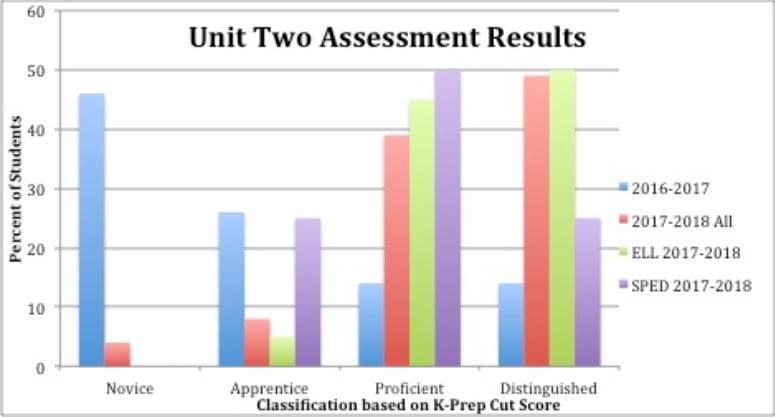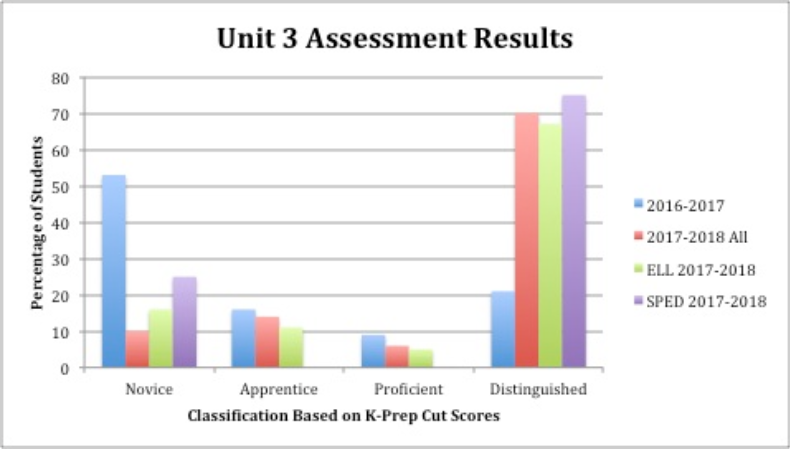We were overjoyed to see Milken Educator Award-winning teacher Brooke Powers’ blog post “Letting Go of What I Thought I Knew” on her experience with our math curriculum. Not only have student outcomes in her classroom dramatically improved, she also has more time to be creative in her instructional planning and help the concepts come alive for students. Read the full text of the post below:
I have always been pretty open about the fact that I felt my “creativity” couldn’t be confined by me being tied down with a text book. I have written numerous posts about it, tweeted it more times than I can count and told just about anyone who would listen that I didn’t need a textbook. Turns out I just was right and wrong. While a traditional textbook may not have been right for me; I have fallen in love with the Illustrative Math curriculum materials this year.
The EdReport on Illustrative Mathematics 6-8 Math Curriculum was released this week, making it the highest scored math program available on the market which only confirmed what I have seen in my classroom this year; the IM curriculum is a game changer for math education in this country. I have been pretty vocal about my IM experiences this year, shared countless student work samples, videos, and pictures but I thought it was time to give other teachers a glimpse of what IM has done to my classroom performance. I am definitely a data driven educator and as much as I have loved using the materials, it means very little if students do not see growth during the course of the year. As you examine the results below please keep the following in mind :
- My class make-up this year is very similar to last year. For the last two years I have taught two math 7 classes (one is a collaborative class for students with disabilities where I have a co-teacher). The percentages of students from each sub-group is nearly identical for each of the last two years.
- I am not a professional researcher. I am a classroom teacher in every way. I simply feel it is imperative I keep as much data as I can in order to make the best decisions I can for students on both a short and long term basis.
- I don’t work for Open Up Resources or Illustrative Math. I have a passion and a heart for providing all students with access to the best math education possible regardless of geography, socio-economic status or other outside factors.
Unit Two Assessment Data:
Unit 2 focused on Proportional Relationships. The following data compares this year’s results with the Ratio & Proportions Part 1 Unit Test from 2016-1017 which most closely aligned with the content for 2017-2018.

Unit Three Assessment Data:
Unit 3 focused on Measuring Circles. The following data compares this year’s results with test questions from the 2016-2017 Geometry Part 2 Assessment that focused on circles.

I was excited for those results but decided to play devil’s advocate and look at if from a more cynical point of view. Last year’s data was based upon teacher written assessments and this year’s were the assessments that came with the Illustrative materials. Although the IM tests are very rigorous and require a great deal of deep thinking I began to wonder how students would do on a more traditional standardized like assessment. We are required to give semester finals in my district so I used that as an opportunity to see how the IM curriculum would transfer to a standardized test. I used our district created final exam questions that were on the content covered during our first four IM units. These were entirely multiple choice and very much like released items from our state K-Prep assessment. The results were astounding.
Highlights from the fall final exam:
- Average score was an 83% compared to 67% last year
- The average score in my collaborative class was only 3% lower than the general ed class nearly eliminating the achievement gap between the two classes
- There we NO NOVICE students in my collaborative class (I have never had that happen in 13 years of teaching
I feel pretty confident in saying that the kids will do just fine on our state test this year. The best part was the kids comments about the test. In years prior, students finished the assessment and said things like, “man that was so hard” or “I know I failed”. This year they had comments like “do kids in other schools just take tests like that all the time? It was so easy”. I truly believe that due to the depth of thinking required in each and every Illustrative lesson, practice problem, and assessment that once students had to take a traditional assessment the cognitive load required was so much less that it presented no challenge to them.
As I said in the beginning of this post, I was concerned about letting go control of my teaching creativity and following a curriculum program but I couldn’t have been more wrong. I have more time to be creative because Illustrative has taken the curriculum design and planning off of my plate so I can find ways to make the workbook come alive for students. Last week we watched a Ferris Bueller clip to understand why distance can’t be negative and then my favorite four minutes of Cosby Show when Theo is learning about being a “regular person” and money before we started looking at integers in the context of money. I was sure that my kids would be lost on the concept of integers without using manipulatives like integers chips. I gave the IM lessons my best shot though, and even though it is embarrassing to admit it, I even understand subtracting integers better after the thoughtfulness and context of the lessons using number lines and elevations. I was able to improve their fluency with some of my favorite games, but the conceptual piece was done in a way far greater than I could have ever done and this teacher is thankful. We took a formative assessment yesterday to see who needed some remediation time with me on adding and subtracting integers…in two classes there were noly two students who didn’t master the concept on the first try. Although I don’t have the data in front of me, I am almost positive that last year I had more than two students at the end of the year that still hadn’t achieved mastery on that skill and this year after one attempt they had it.
I have felt the need to share this data for a while but not for attention or kudos. I truly believe the Illustrative Math curriculum is what is right for kids. All kids deserve the chance to truly understand, comprehend, and enjoy math and this program provides that opportunity in an easy to use format. It is a game changer in grades 6-8 mathematics. A free, accessible, and differentiated curriculum seems to good to be true, but this isn’t just good it is phenomenal. Thank you IM for chaining math instruction for both me and my students, I am beyond grateful.

